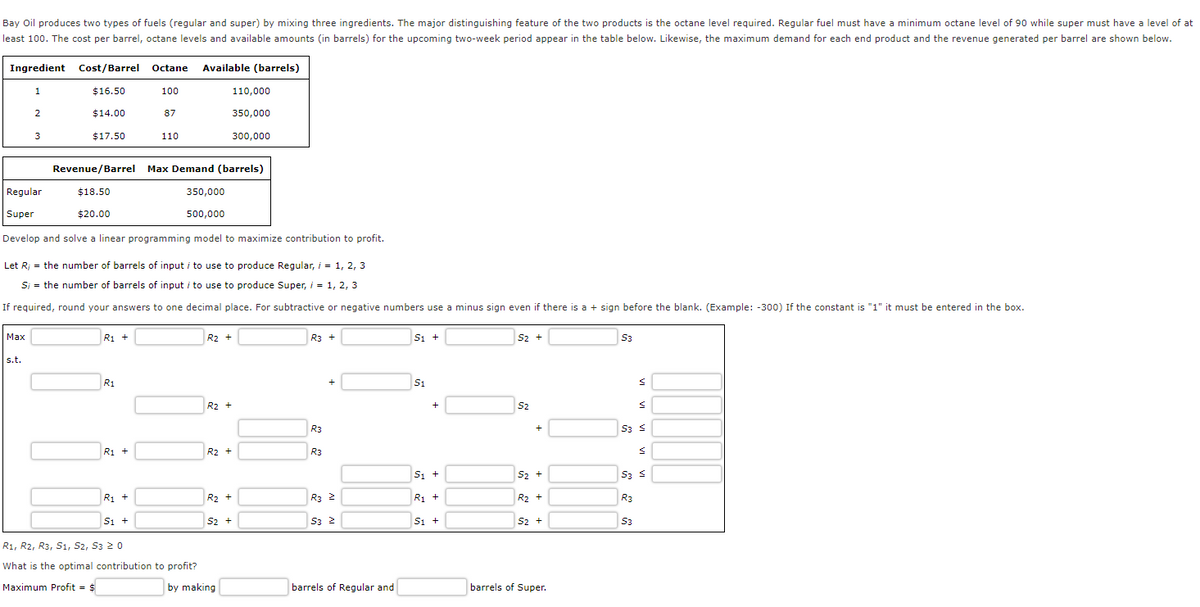Bay Oil produces two types of fuels (regular and super) by mixing three ingredients. The major distinguishing feature of the two products is the octane level required. Regular fuel must have a minimum octane level of 90 while super must have a level of at least 100. The cost per barrel, octane levels and available amounts (in barrels) for the upcoming two-week period appear in the table below. Likewise, the maximum demand for each end product and the revenue generated per barrel are shown below. Ingredient 1 2 3 Regular Super Max s.t. Cost/Barrel $16.50 $14.00 $17.50 Revenue/Barrel Max Demand (barrels) $18.50 $20.00 Develop and solve a linear programming model to maximize contribution to profit. R1 + Octane Available (barrels) 100 R1 87 R1 + 110 Let R, the number of barrels of input/ to use to produce Regular, 1, 2, 3 Si the number of barrels of input/ to use to produce Super,/= 1, 2, 3 If required, round your answers to one decimal place. For subtractive or negative numbers use a minus sign even if there is a + sign before the blank. (Example: -300) If the constant is "1" it must be entered in the box. 350,000 500,000 110,000 R2 + 350,000 300,000 R2 + R₁ + S1 + R1, R2, R3, S1, S2, S3 20 What is the optimal contribution to profit? Maximum Profits by making R2 + R₂ + S2 + R3 + R3 R3 R3 2 53 2 barrels of Regular and S1 + S1 + S₁ + R₁ + S1 + S2 + $2 S2 + R₂ + S2 + barrels of Super. S3 S S S3 S S S3 S R₂ 53
Bay Oil produces two types of fuels (regular and super) by mixing three ingredients. The major distinguishing feature of the two products is the octane level required. Regular fuel must have a minimum octane level of 90 while super must have a level of at least 100. The cost per barrel, octane levels and available amounts (in barrels) for the upcoming two-week period appear in the table below. Likewise, the maximum demand for each end product and the revenue generated per barrel are shown below. Ingredient 1 2 3 Regular Super Max s.t. Cost/Barrel $16.50 $14.00 $17.50 Revenue/Barrel Max Demand (barrels) $18.50 $20.00 Develop and solve a linear programming model to maximize contribution to profit. R1 + Octane Available (barrels) 100 R1 87 R1 + 110 Let R, the number of barrels of input/ to use to produce Regular, 1, 2, 3 Si the number of barrels of input/ to use to produce Super,/= 1, 2, 3 If required, round your answers to one decimal place. For subtractive or negative numbers use a minus sign even if there is a + sign before the blank. (Example: -300) If the constant is "1" it must be entered in the box. 350,000 500,000 110,000 R2 + 350,000 300,000 R2 + R₁ + S1 + R1, R2, R3, S1, S2, S3 20 What is the optimal contribution to profit? Maximum Profits by making R2 + R₂ + S2 + R3 + R3 R3 R3 2 53 2 barrels of Regular and S1 + S1 + S₁ + R₁ + S1 + S2 + $2 S2 + R₂ + S2 + barrels of Super. S3 S S S3 S S S3 S R₂ 53
Practical Management Science
6th Edition
ISBN:9781337406659
Author:WINSTON, Wayne L.
Publisher:WINSTON, Wayne L.
Chapter4: Linear Programming Models
Section: Chapter Questions
Problem 73P
Related questions
Question
100%
Can you please fill out the main boxes in a way that can be easily deciphered??

Transcribed Image Text:Bay Oil produces two types of fuels (regular and super) by mixing three ingredients. The major distinguishing feature of the two products is the octane level required. Regular fuel must have a minimum octane level of 90 while super must have a level of at
least 100. The cost per barrel, octane levels and available amounts (in barrels) for the upcoming two-week period appear in the table below. Likewise, the maximum demand for each end product and the revenue generated per barrel are shown below.
Ingredient
1
Max
2
s.t.
3
Cost/Barrel
$16.50
$14.00
$17.50
Revenue/Barrel
$18.50
$20.00
Max Demand (barrels)
Regular
350,000
500,000
Super
Develop and solve a linear programming model to maximize contribution to profit.
Let R; = the number of barrels of input i to use to produce Regular, i = 1, 2, 3
S; = the number of barrels of input i to use to produce Super, i = 1, 2, 3
If required, round your answers to one decimal place. For subtractive or negative numbers use a minus sign even if there is a + sign before the blank. (Example: -300) If the constant is "1" it must be entered in the box.
R₁ +
R1
R1 +
Octane Available (barrels)
100
87
R₁ +
S1 +
110
R1, R2, R3, S1, S2, S3 2 0
What is the optimal contribution
Maximum Profit = $
to profit?
R₂ +
R₂ +
110,000
350,000
300,000
R2 +
R₂ +
S2 +
by making
R3 +
R3
R3
+
R3 2
S3 2
barrels of Regular and
S1 +
S1
+
S1 +
R₁ +
S1 +
S2 +
S2
+
S2 +
R₂ +
S2 +
barrels of Super.
S3
S
S
S3 S
S
S3 S
R3
S3
Expert Solution
This question has been solved!
Explore an expertly crafted, step-by-step solution for a thorough understanding of key concepts.
This is a popular solution!
Trending now
This is a popular solution!
Step by step
Solved in 2 steps with 5 images

Recommended textbooks for you

Practical Management Science
Operations Management
ISBN:
9781337406659
Author:
WINSTON, Wayne L.
Publisher:
Cengage,

Practical Management Science
Operations Management
ISBN:
9781337406659
Author:
WINSTON, Wayne L.
Publisher:
Cengage,